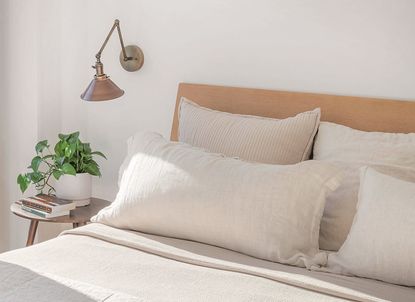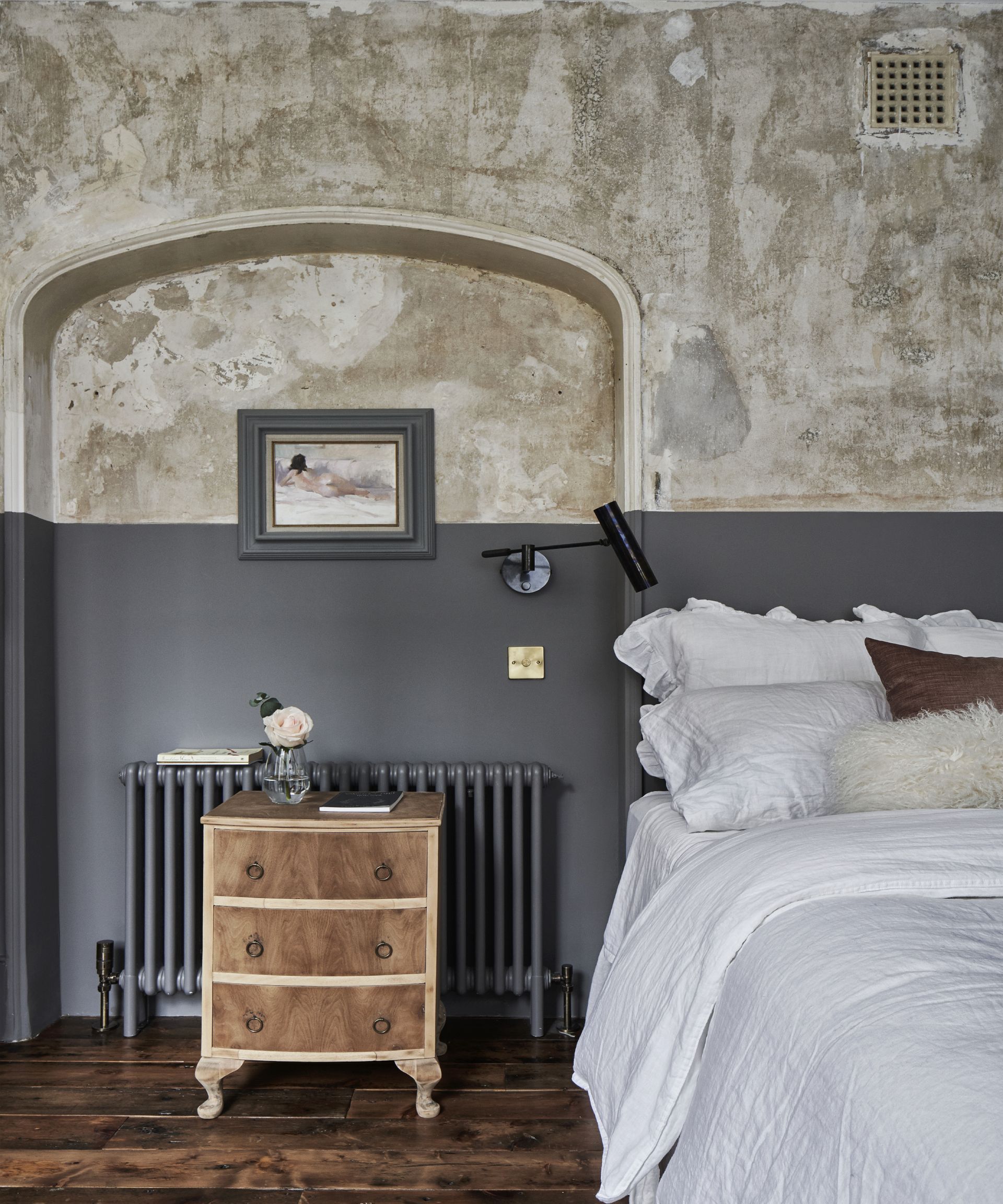How many pillows should you be sleeping with? These sleep experts told me I'm using too many
A stack of pillows - or a lack of them - can have serious consequences for your spine, say these sleep experts


Pillows are an oft-neglected element of our bedding. We tend to spend hours agonizing over the perfect mattress, from the material to the firmness and everything in between, but our head support is somewhat of an afterthought. The problem is, there's one common mistake millions - if not billions - of us are making as a result: sleeping with the wrong number of pillows.
Like mattresses, we all have our preferences when it comes to pillows - soft or firm, plump or flat, down or foam - but personal comfort shouldn't be the only factor you consider. There's also the question of supportiveness, and the best pillows should keep your head and neck aligned with your spine.
But let's be honest, how many of us make up for lack of height or plumpness by stacking multiple pillows on top of each other? As a fan of cloud-like comfort, I'm a proud two-pillow sleeper (two plump pillows at that, and three if they're too flat). However, according to experts, stacking your pillows can have serious consequences for the alignment of your spine. The question is, how many is the right amount for the job? I asked some sleep and bedding experts for their insights, and their answers might surprise you...
How many pillows should we sleep with?

Ever tried to sleep on a mountain of fluffy hotel pillows before deciding to toss them all on the floor? Perhaps you're the total opposite and feel outraged when your friend offers you nothing but a thin piece of material when you stay in their guest bedroom. The truth is, we all have our differences when it comes to the cushioniness of our pillows, and meeting those needs is certainly going to help us sleep better. Whether or not they support our health and wellbeing, though, is another matter.
No prizes for knowing this, but pillows exist to support our head during sleep. The ultimate goal is to keep your head, neck, and spine aligned so they are as close as possible in shape while lying down as they are when standing up. Too many pillows or, conversely, too few, will therefore cause your head to rest too low or high than it should (this is called the 'loft').
'The height of your pillow is essential,' explains Tom Greenspan, a Sleep Science Coach, and CEO of VS Mattress. 'When lying on your back, a pillow should fill in the gap between your neck and the mattress, while when sleeping on your side, it should be thick enough to support your head and neck without pushing them too far forward or backward. The ideal amount of loft should align with the natural curvature of your spine.'
Get this wrong and your pillow can have serious consequences on your body, both long term and short term. 'Sleeping with too few or too many pillows can cause neck and back pain and shoulder stiffness due to misalignment of the spine,' Tom adds. 'If you use a pillow that is too soft or firm for your preferred sleeping position, it can also disrupt your breathing and lead to further discomfort.'
Here's the catch. Since all our bodies are different shapes and sizes, and we all sleep in different positions, the amount of pillows we ought to sleep with will differ from person to person, and will also depend on the height (or loft) of the pillows in question.
What are the conditional factors?

When it comes to how to choose the perfect pillow, and how many you use, there a quite a few factors to consider. 'Generally, the amount of pillows you need is based on your preferred sleeping position,' explains Tom. 'Side sleepers typically need a firmer pillow to keep their head and neck aligned, while back sleepers require a softer pillow to cushion their head and neck contours. Stomach sleepers should ideally avoid pillows entirely as they can cause further misalignment of the spine.'
With the firmness out of the way, what about the quantity? Dr. Matt Tanneberg, a Chiropractor and Certified Strength and Conditioning Specialist (CSCS) at Body Check, has some insights.
Side sleepers
The vast majority of us are side sleepers. Generally, you'll want two pillows if you sleep on your side, according to Matt (depending on how thick they are, of course). 'If you don’t have enough pillows underneath your head or you have too many, your neck will be cranked to the side one way or the other,' he explains. 'Usually, you will need a thicker pillow with more supportive material so that your head doesn’t sink in causing excess lateral flexion of your neck.' For this, he suggests a firm material like latex.
Back sleepers
The second most common sleeping position is on your back, also known as the supine position. If you sleep on your back, Matt suggests one thin pillow to prevent your head flexing too far forward. 'The thinner the pillow, the better if you are a back sleeper,' he says. 'There are also specific pillows that are made for those who sleep on their back that have extra cushion only on the lower half of the pillow which is used to support your neck.'
Tummy sleepers
For some of us, sleeping face downwards is the most comfortable way to snooze. 'If you sleep on your stomach, you want either one thin pillow or no pillows at all so that your head isn't stuck back in extension all night,' explains Matt. 'Look for very thin pillows to keep your head as neutral as possible while being on your stomach, and you'll want a pillow that's smaller in size because usually you'll only use a corner of it.'
Snorers
As Matt explains, snoring typically occurs when lying flat on your back. To prevent it, you should try sleeping in a more upright position. 'Prop multiple pillows not only underneath your head but behind your upper back, as well,' says Matt. 'You don’t want to prop pillows just behind your neck because you will cause excess flexion of the neck, which will put a lot of strain on it. By propping up your whole upper body, you are almost in a reclined, sitting position which will be more comfortable and will help with the airflow through your nostrils.'
Of course, some of us alternate between front, back, and side throughout the night. If this is the case, it's best to choose a single mid loft, medium desity pillow as a happy medium.
Is it a good idea to sleep with no pillow at all?
If deciding how many pillows to sleep with is keeping you up at night, you might be questioning if it's better to sleep without a pillow at all. The answer is one that divides experts, but generally, ditching the pillow completely is only really an option for certain types of sleepers.
Those who sleep on their backs or stomachs might find it more comfortable to sleep without a pillow, helping to alleviate neck pain during the day. This is especially true for those who work at a desk and tend to crane forward during the day since lying flat on your back without a pillow brings your head and neck to a neutral position.
However, it all depends on your own body shape and preferences, and sleeping without a pillow is a firm no for side sleepers. 'Without a pillow, your head and neck can be misaligned and cause pain over time,' Tom notes. 'It's best to pick the right amount of loft that will keep you comfortable throughout the night.'
Our pick of the best pillows to support your spine

Material: Ethically-sourced down
Price: $112.20

Material: Memory foam with layers of cooling gel
Price: $49

Material: Tempur-Pedic® memory foam
Price: $134.99
Be The First To Know
The Livingetc newsletter is your shortcut to the now and the next in home design. Subscribe today to receive a stunning free 200-page book of the best homes from around the world.

Lilith Hudson is the News Editor at Livingetc, and an expert at decoding trends and reporting on them as they happen. Writing news, features, and explainers for our digital platform, she's the go-to person for all the latest micro-trends, interior hacks, and color inspiration you need in your home. Lilith discovered a love for lifestyle journalism during her BA in English and Philosophy at the University of Nottingham where she spent more time writing for her student magazine than she did studying. After graduating, she decided to take things a step further and now holds an MA in Magazine Journalism from City, University of London, with previous experience at the Saturday Times Magazine, Evening Standard, DJ Mag, and The Simple Things Magazine. At weekends you'll find her renovating a tiny one-up, one-down annex next to her Dad's holiday cottage in the Derbyshire dales where she applies all the latest design ideas she's picked up through the week.
-
 The 12 Best Table Lamps for Reading —I'm a Certified Bookworm (and Shopping Expert)
The 12 Best Table Lamps for Reading —I'm a Certified Bookworm (and Shopping Expert)When it comes to table lamps for reading, I don't mess around. If you're the same, this edit is for YOU (and your books, or course — and good recommendations?)
By Brigid Kennedy Published
-
 "It's Scandi Meets Californian-Cool" — The New Anthro Collab With Katie Hodges Hits Just the Right Style Note
"It's Scandi Meets Californian-Cool" — The New Anthro Collab With Katie Hodges Hits Just the Right Style NoteThe LA-based interior designer merges coastal cool with Scandinavian simplicity for a delightfully lived-in collection of elevated home furnishings
By Julia Demer Published

